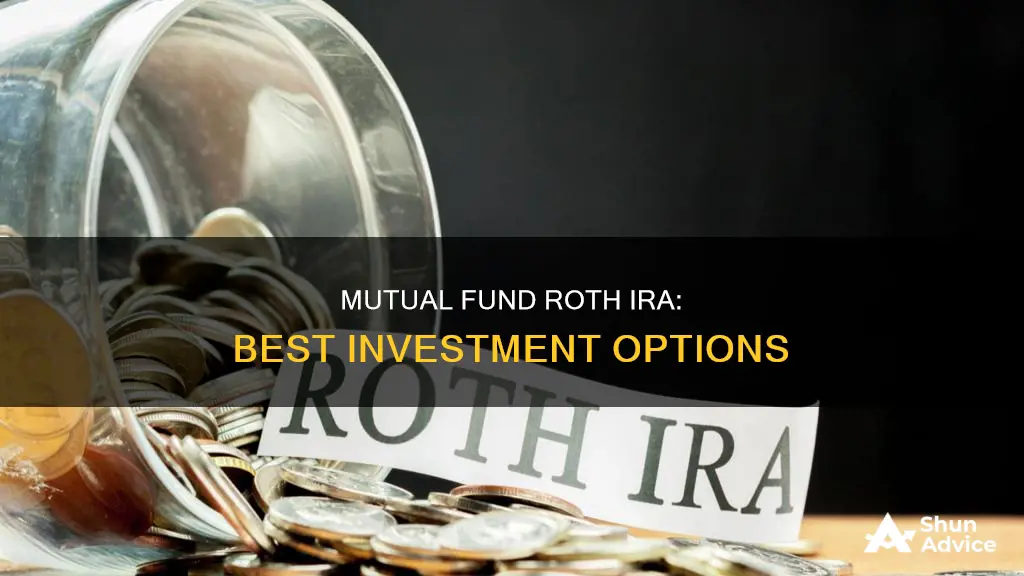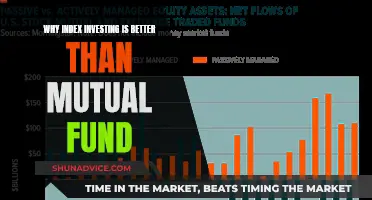
A Roth IRA is a powerful retirement savings tool that allows you to grow your money tax-free and make tax-free withdrawals in retirement. When choosing mutual funds for your Roth IRA, it's important to consider your risk tolerance, investment horizon, and the mix of stocks and bonds in your portfolio. Here's an introduction to guide your decision-making process.
| Characteristics | Values |
|---|---|
| Investment Options | Stocks, Bonds, Mutual Funds, ETFs, Index Funds, REITs, Cryptocurrency |
| Tax Efficiency | Tax-free growth and withdrawals |
| Contribution Limits | $7,000 under age 50; $8,000 aged 50 and over |
| Eligibility Requirements | Modified Adjusted Gross Income below specific thresholds |
| Recommended Funds | Vanguard Dividend Growth Fund (VDIGX), Dodge & Cox International Stock Fund (DODFX), FPA Crescent Fund (FPACX), Vanguard 500 Index Fund Admiral Shares (VFIAX), Fidelity Contrafund (FCNTX), Cohen & Steers Quality Income Realty Fund (RQI), Avantis All Equity Markets Value ETF (AVGV) |
| Investment Strategies | Long-term, buy-and-hold, diversification, risk tolerance, age |

Stocks and bonds
Diversification
Broad-based stock and bond index funds are good starting points for a Roth IRA as they provide diversification across different asset classes and market sectors. You can invest in a mix of U.S. and global stock index funds and a U.S. bond index fund to achieve diversification. Exchange-traded funds (ETFs) and conventional mutual funds can also help meet your diversification needs at a minimal cost.
Long-Term Perspective
When investing in a Roth IRA, it is important to adopt a long-term, buy-and-hold approach. This type of account is designed for retirement savings, so you should focus on investments that have strong long-term growth potential while minimising short-term risks.
Cost Minimisation
Minimising costs such as fees is crucial when investing for the long term, as these expenses can significantly impact your returns. Index funds, which passively invest in the securities included in a particular index, tend to have lower management fees than actively managed funds and often outperform them over time.
Risk Tolerance and Time Horizon
The appropriate mix of stocks and bonds depends on your risk tolerance and how far you are from retirement. If you are risk-averse, you may opt for a larger allocation of bonds, which are generally considered less risky than stocks. As you approach retirement, you may also want to shift towards less risky assets. Traditional investing wisdom suggests a 60/40 portfolio (60% stocks and 40% bonds) for most investors, with the proportion of stocks decreasing as the investor ages. However, some financial advisors recommend holding a higher percentage of stocks throughout your career to enhance potential returns.
Specific Investment Options
When investing in stocks and bonds through a Roth IRA, you have several options, including:
- S&P 500 index funds: These funds aim to replicate the performance of the S&P 500 Index, which consists of large-cap U.S. companies like Amazon, Apple, and Microsoft. They offer broad diversification and the potential for solid gains.
- Dividend stock funds: These funds invest in companies that pay dividends, often in mature industries with stable cash flows. Dividends can be reinvested to compound returns over time.
- Value stock funds: These funds focus on stocks that are relatively undervalued compared to the market, offering the potential for lower volatility and attractive returns. Some value stocks also pay dividends.
- Nasdaq-100 index funds: These funds provide exposure to the largest companies trading on the Nasdaq exchange, including many tech firms. This option offers high potential returns but may be more volatile.
- Target-date funds: These funds automatically adjust your asset allocation based on your target retirement date, shifting from riskier stocks to safer bonds as you get closer to retirement.
- Small-cap stock funds: These funds invest in small-cap stocks, which have the potential for high growth but also come with higher risk.
- Bond funds: While they may not perform as well as stocks over the long term, bond funds can generate meaningful income that is tax-free within a Roth IRA. Core bond funds that hold highly-rated bonds offer lower risk, while high-yield bond funds offer higher returns but with increased risk.
The Best Places to Invest in Exchange-Traded Funds Directly
You may want to see also

Dividend stocks
Firstly, Roth IRAs let investors grow their savings tax-free. Dividends earned in a Roth IRA are not subject to income taxes, and investors can roll dividends back into the dividend fund to keep payouts growing year after year. Secondly, dividend stocks can add stability to your portfolio. Companies that pay dividends tend to be in mature industries and are less volatile than average funds.
When choosing dividend stocks for your Roth IRA, it's important to consider the company's dividend growth and dividend yield. A company that consistently increases its dividend displays financial stability. A dividend yield that is too high (generally above 4%) may indicate that the payout is unsustainable or that investors are selling the stock.
- Vanguard Dividend Growth Fund (VDIGX)
- Dodge & Cox International Stock Fund (DODFX)
- FPA Crescent Fund (FPACX)
- Coca-Cola
- Johnson & Johnson
- Estee Lauder Cos. Inc. (EL)
- United Parcel Service Inc. (UPS)
- Washington Trust Bancorp Inc. (WASH)
- Hormel Foods Corp. (HRL)
- Kimberly-Clark Corp. (KMB)
It's important to note that dividend stocks may not experience the same price growth as other stocks, especially small caps and growth stocks. Additionally, dividends in taxable brokerage accounts are taxed in the year they are received, so for investors in high-income brackets, dividend stocks may not be the most tax-efficient option.
Equity Funds: When to Invest for Maximum Returns
You may want to see also

Growth stocks
When it comes to growth stocks, these are companies that are expanding their profits and sales at a steady rate. Technology companies are often a common example of growth stocks, as they bring new, improved gadgets to the market.
- Dividend stock funds: Companies that pay dividends are usually in mature industries and generate a lot of cash. The best companies increase their payouts annually, and these stocks tend to be less volatile than average. Dividend stock funds can be particularly attractive in a Roth IRA because the dividends are not subject to tax.
- Value stock funds: Value stocks are priced lower than the rest of the market, making them relative bargains. They tend to be less volatile than the rest of the market and often have good returns over time. Many value stocks also pay dividends.
- Nasdaq-100 index funds: Nasdaq-100 index funds focus on the largest companies trading on the Nasdaq exchange, which includes many tech firms. This kind of fund gives you high exposure to top tech players, and you can potentially compound your money at attractive rates.
- Small-cap stock funds: Small-cap stock funds focus on small companies, which have the potential to grow quickly over time. They can be a good investment for a Roth IRA, allowing you to compound your money. You can invest in a fund that tracks the Russell 2000 index, for example, to benefit from a well-diversified portfolio of small-cap holdings.
- Vanguard Dividend Growth Fund (VDIGX): This mutual fund holds stocks across several sectors, including healthcare, technology, and consumer staples. It focuses on top companies that can grow their dividends over time, such as Microsoft and Northrup Grumman Corp. However, returns from dividend-paying stocks may sometimes trail returns from the overall stock market.
Actively Managed Funds: Where to Invest Your Money?
You may want to see also

REITs
Real estate investment trusts (REITs) are a great way to diversify your portfolio and balance out your investments. They are a good option if you want to invest in real estate using your Roth IRA.
When picking a REIT, you can research historical returns, read up on the management team, and read the prospectus. REITs are also very liquid, so if you change your mind, you can sell and buy another REIT on the same day.
Some risks to consider when investing in REITs are that they are directly affected by the health of the real estate market. If interest rates rise, you could lose value. If you shift all your funds to REITs, you may also lose sight of diversification.
Overall, REITs are a great option for those looking to invest in real estate through their Roth IRA and want a more hands-off approach while still retaining stability and tax advantages.
Funding Sources for Private Investment: Where Does Money Come From?
You may want to see also

High-yield bond funds
- Vanguard High-Yield Corporate Fund (VWEHX): This fund has a low expense ratio of 0.22% and invests in medium and lower-quality corporate bonds, with an average effective duration of around three to four years.
- IShares iBoxx $ High Yield Corporate Bond ETF (HYG): A popular high-yield bond ETF with an expense ratio of 0.49%. It aims to track the performance of an index of US high-yield corporate bonds, with a weighted average maturity of about four years.
- JPMorgan BetaBuilders USD High Yield Corporate Bond ETF (BBHY): This ETF seeks to replicate the performance of an index of US high-yield corporate bonds and has an expense ratio of 0.15%.
- SPDR Portfolio High Yield Bond ETF (SPHY): This ETF aims to match the performance of a high-yield bond index, including US high-yield bonds with a maturity of at least one year and a minimum amount outstanding of $250 million. It has a low expense ratio of 0.05%.
- VanEck High Yield Muni ETF (HYD): This ETF seeks to match the performance of an index tracking the US high-yield long-term tax-exempt bond market. The bonds are generally exempt from federal income taxes, resulting in a lower stated yield than taxable funds. It has an expense ratio of 0.32%.
- Fidelity Capital & Income Fund (FAGIX): This fund has been in operation for nearly 50 years and includes defaulted securities and debt from companies in financial trouble. It has a strong performance record, with average annual returns over the past 10 years that are about 65% better than its Morningstar high-yield bond fund category.
- American Funds American High-Income Trust Class F-1 (AHTFX): This fund has improved credit quality and has recently shifted towards safer BB and B-rated debt, reducing default risk. It has outperformed its Morningstar high-yield bond fund group average over the previous one, three, five, 10 and 15 years.
- Fidelity Floating Rate High Income Fund (FFRHX): This fund focuses on lower-credit-quality bank loans from non-investment-grade companies with strong balance sheets and high free cash flow. It has a very low average effective duration, limiting credit and duration risk. It has outperformed its category's average annual return over the past one, three, five and 10 years.
Mutual Fund Investment: Best Day to Invest and Grow Wealth
You may want to see also
Frequently asked questions
Some highly-rated mutual funds for a Roth IRA include Vanguard Dividend Growth Fund (VDIGX), Dodge & Cox International Stock Fund (DODFX), and FPA Crescent Fund (FPACX).
A Roth IRA is a tax-advantaged individual retirement account, which allows you to grow your money tax-free and then withdraw it without paying taxes in retirement.
Good investments for a Roth IRA include S&P 500 index funds, dividend stock funds, value stock funds, Nasdaq-100 index funds, and target-date funds.







